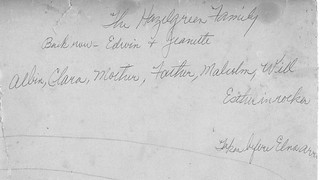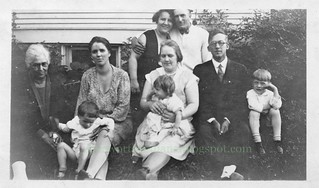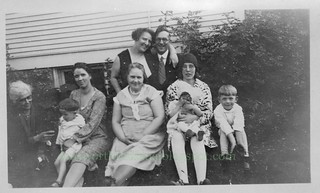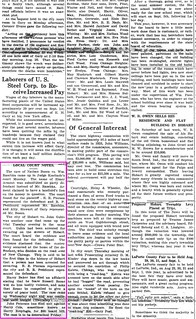Since this blog is full of Burges and Frames, I thought I should go back to 1912 and post this obituary, skipped over the first time …
 (Click on image to enlarge)
(Click on image to enlarge)
Hobart Gazette 1 Mar. 1912.
… not that it's particularly helpful, since it fails to name her parents or her children. But with a little research, we can try to remedy that.
Looking at the
1850 Census, we find J. and Julia Burge farming in Chautauqua County, New York. While the census does not include what relationship each member of the household has to its head, this household includes a 17-year-old Mahala Weaver, a 13-year-old Byron, and a nine-year-old Henry. This suggests that the obituary gave the date of Mahala's first marriage incorrectly. In the
1860 Census, still in Chautauqua County, we find a 27-year-old Mahala Weaver living with a 31-year-old carpenter, Oren Weaver, and a three-year-old Ida.
Sometime after 1860, the family came west. Orrin died in Porter County on June 9, 1866.** In 1867 Mahala married Levi Frame in Porter County (
Indiana Marriage Collection). While I can't find them in the
1870 Census, another source* seems to place Levi Frame in Christian County, Illinois, by 1870; and that is where we find Mahala in the
1880 Census, by which time she was widowed. A child of her first marriage, the 17-year-old Arthur Weaver, was living with her, as well as a 10-year-old girl named Effie Brown, who was described as an adopted daughter. The children of the second marriage were: John (11 years old), Burton (10), Frank*** (6), and Jesse (4).
So that gives us the five sons mentioned in the obituary. I suppose the one surviving daughter was from the first marriage.****
Sometime during the next 20 years, Mahala left Illinois for Indiana. In the
1900 Census, she was living in Hobart with her youngest son,
Jesse.
Well. That was a lot of research for a little bit of information.
♦ ♦ ♦
Elsewhere on that page from the
Gazette, we find obituaries of people we've mentioned before —
Patrick Sullivan and
Ericka Pearson.
Marion Wilson was a member of the Wilson family of Union Township, which I've only
recently noticed. The obituary says he was buried in the Boiling Springs cemetery, which may be the Leonard Family cemetery on Boiling Springs Road listed on the
NWIGS site. If the obituary is correct, it seems he was later moved, as today he rests in
Blachly Cemetery. His wife was a daughter of
Harriet Towl Ragen.
________________________
*Ancestry.com.
Selected U.S. Federal Census Non-Population Schedules, 1850-1880 [database on-line]. Provo, UT, USA: Ancestry.com Operations, Inc., 2010.
**According to his
grave marker in Mosier Cemetery; the obituary states 1865.
***I swear the enumerator wrote "Freak," but that can't be right.
****Based on information at
findagrave.com, I believe her name was Blanch.




























